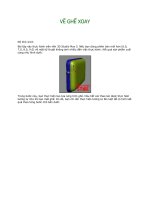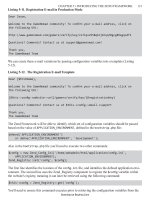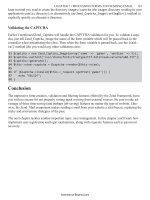Building Websites with Joomla! 1.5 phần 10 ppt
Bạn đang xem bản rút gọn của tài liệu. Xem và tải ngay bản đầy đủ của tài liệu tại đây (1.52 MB, 46 trang )
A Website with Joomla!
[ 318 ]
Formatting Step by Step
Pattern
By looking at the HTML code, a pattern can easily be recognized:
Ruth has dened the output of the module with style="xhtml" in index.php.
With this setting and with the parameter setting of the module (Module manager),
all of the modules used here are output to "list" in <div> tags. These <div>
containers contain a header and lists that are dened with the <h3> HTML tag. The
links are in the lists. A lot of design options are available with this, since all of the
HTML tags can be programmed either directly or with Joomla!'s classes.
The modules have an easy-to-see image background, which is put there with all of
the modules and which was therefore dened in the encompassing HTML tag. All of
the tags that Ruth has invented herself for her HTML structure are in the template.
css le. This is also true for the ubiquitous page navigation.
.naviside CSS code:
.naviside {
background: url( /images/naviside_top.jpg) top left; /*image
background*/
width: 210px; /*width*/
vertical-align: top; /*top alignment of the content*/
border: 0px; /*border*/
padding: 0px; /*padding*/
margin: 0px; /*margins*/
background-color: #fff; /*background color*/
text-align: left; /*alignment at the left border*/
float: left; /*total alignment inside of the HTML structure*/
}
In the next step, Ruth assigns properties to the <div> tags that are here activated
with the moduletable_menu and moduletable (login form) classes, which are to be
valid for all menus: width, distance from each other, and a color. She only needs to
know the two classes, moduletable and moduletable_menu, for this.
The moduletable and moduletable_menu classes are Joomla! default classes. For
purposes of overview, Ruth has saved the classes she has dened herself separated
from the default Joomla! classes in the joomla_stuff.css and template.css
CSS les.
Chapter 16
[ 319 ]
CSS code:
.naviside .moduletable, .moduletable_menu
{
width: 210px; /*width*/
background: none; /*background*/
margin-top: 18px; /*marin outside of the module, to the top*/
text-align: left; /*left-aligned*/
padding: 0px; /*no padding from the edge of the module to the
content*/
}
Title of the Module
It is easy to create a title that looks the same for all modules by addressing the
headline of the tables directly with its <h3> tag within the module.
To do this, rst state the class again in the CSS, here .navitop. With the .navitop
class, all modules are within this <div>. This statement has the effect that only
header statements inside the .navitop section are formatted with these CSS
commands. And now the crucial <h3> is added. Ruth set up the title with a
background image in order to have more variety in the look of the menus.
Module title:
/*defining the header of the module on the left */
.navitop h3 {
font: 18px/18px Times New Roman, serif; /*font size/-type*/
font-weight: normal; /*font weight*/
color: #A49A66; /*font color*/
background: url( /images/blatt.gif) top left; /*backround image*/
background-repeat: no-repeat; /*repeat background image*/
padding-left: 25px; /*padding on the left*/
height: 25px; /*div height*/
width: 185px; /*width*/
}
A Website with Joomla!
[ 320 ]
Menu Items
After the title is done, the links that are set up in the HTML lists have to be formatted.
Ruth did not want to have any dots before the links and wanted to get rid of the
usual indentation of lists. She uses the Joomla! predened .menu and .moduletable
CSS classes to address the list.
Formatting the list in the modules:
ul.menu, .naviside .moduletable ul
{
list-style: none; /* list without dot*/
display: block; /* block element, */
/* formatted as boxes */
width: 210px; /* width */
margin: 0px; /* margins */
border: 0px; /* border */
padding: 0px; /* padding */
}
Divider Lines
Ruth wanted to show the individual links separated by lines. For this, she addresses
the li tags of the lists in a specic way:
ul.menu li {
border-bottom: 1px dotted #ccc; /* bottom border */
}
The subheadings of the links can be addressed separately; in this example they have
an indention on the left border.
Chapter 16
[ 321 ]
Subheadings:
/*Formatting the lists of the subheadings*/
ul.menu ul {
/* the margin acts like an indention of the text*/
margin-left: 10px;
background-color: #EEE; /* other background color */
width: 200px; /* smaller width */
}
And the subheadings get a differently formatted bottom border that ts with the
background color.
ul.menu ul li {
border-bottom: 1px solid #fff; /*bottom border*/?
}
Each list item could be formatted separately since every li tag has its own class.
level1 item1, .level1 item2 parent, .level1 item3 parent, .level1
item4
The Actual Links
Now we come to the links themselves. The formatting addresses the a tag that is
positioned in the ul list with the .menu class.
All links should look like this:
ul.mainmenu a {?
text-decoration: none; /* link without underline */
color: #6B5E588; /* color of the font */
font-size: 11px; /* font size */
padding-left: 10px; /* distance of the text to the border */
}
The hover effect changes the background or the font color of the link when the
mouse rolls over it. Ruth has set it up in the following way:
ul.menu a:hover {
color: #CAC303;
text-decoration: none;
}
A Website with Joomla!
[ 322 ]
And nally, the link of the currently active page is specially highlighted with the
help of the following class:
.menu li#current a {
color: #B22819; /* font color */
}
and done!
M. Bertrand is delighted and now nds formatting with CSS a lot easier after this
explanation. His head is still spinning a little, but Ruth also gives him the www.
w3schools.com/css/ link. That site has a good description of all of the attributes
that can be dened with CSS.
Changes for Joomla! Version 1.5
If you have already built templates with Joomla! 1.0.x, here is the good news: Joomla!
1.5 is backward compatible in legacy mode!
There are, however, a few pitfalls that you should be aware of. The previously used
mosload() commands in the PHP code and the old CSS classes of the index.php of a
template don't work any more at certain places since some formatting has changed.
Changes to the Menus
There are now many options for formatting modules and components compared
to Joomla! 1.0. You were able to control the modules in different ways before by
assigning them their own CSS class extensions; now their HTML output can also be
controlled with the following statements in the template's own index.php.
These are the options that you can select from:
table (default): The module is displayed in a table column.: The module is displayed in a table column.
horz: The module is displayed horizontally and output into the cell of a
surrounding table.
xhtml: The module is output in a simple div element.
rounded: The output is done in a format that enables round corners; with this
the name of the <div> changes from moduletable to module.
none: The module is output witout any formatting.
This is great! This allows you to design a Joomla! site without any tables and to
organize the content logically (as needed for barrier freedom).barrier freedom).).
By using <div> tags you can now design with fewer constraints than with HTML
tables, which were never designed for that purpose anyway.
•
•
•
•
•
Chapter 16
[ 323 ]
Installation on the Webserver
M. Bertrand's local website is now approximately what he had imagined. He has
been looking for a provider for his website in the last few weeks and after a long
search has become a customer of a small company in the neighborhood. This
company offered M. Bertrand an SSL-protected administration interface by the name
of Plesk for the setup of his webserver, the database, the email congurations, etc.
PHP runs in Safe Mode. The database can be administered with an installed
phpMyAdmin. M. Bertrand wanted to have web-based administration for his server,
because he did not want to have to learn tedious conguration les.
There are numerous other interfaces, such as Conxx, Visas, and
Webmin. Many providers, like 1&1, Strato, Hetzner, and others use their
own developments. We will discuss Plesk briey as an example; other
interfaces work similarly.
How to Do the Installation
M. Bertrand used the Joomla! web installer to install the program in his local
environment. Subsequently he spent a morning entering data and he does not want
to lose these with the live installation. There are at least two options:
He could load all of the Joomla! les from FTP to the server at his provider,
change the conguration le manually, and import the database with
phpMyAdmin.
He could load a Joomla! le to the server at his provider from FTP, install
it with the Joomla! installer, and then import the data of the database with
phpMyAdmin.
M. Bertrand decides on the rst option. In order to be able to start the installation, he
needs access data for FTP, MySQL, and the domain name of course.
He nds the following access data in his administration interface.
FTP
Host: bertrand.cocoate.com
User: fusfusfus
Password: pwpwpw
•
•
A Website with Joomla!
[ 324 ]
MySQL
Host: localhost
User: dbusdbus
Password: pwpwpwpw
Database: dbdbdb
Installation of Joomla! at the Provider
M. Bertrand starts his FTP program and enters the necessary information. He
received the FTP program from his provider free of charge (you can nd a free-ware
FTP program at www.filezilla.sourceforge.net/).
He transfers his existing installation from the c:\xampplite\htdocs\bertrand
subdirectory using FTP into the httpdocs subdirectory on his provider's server.
He backs up the configuration.php le on his own PC and opens it with an editor
or with the WordPad program.
A few values have to be changed so that his local version runs on the server as well.
/* Database Settings */
var $host = 'localhost'; // normally set to localhost
var $user = ''; // MySQL username
var $password = ''; // MySQL password
var $db = ''; // MySQL database name
After making the changes, he loads the le using FTP into the httpdocs directory on
the server and assigns it chmod 0777 rights. FTP programs can execute this command
and with it can assign access rights to a directory. Joomla! requires at least chmod
755; chmod 644 is sufcient for the les.
Importing the Data
In order to be able to import the data to the MySQL database of the provider,
they rst have to be exported from the local xampplite version. M. Bertrand calls
http://localhost/phpmyadmin from the browser, selects the bertrand database
and clicks on the Export tab.
Chapter 16
[ 325 ]
He clicks on Select All to pick all of the tables for export.
In the Structure section he selects Structure and DROP TABLE. DROP
TABLE inserts an additional SQL command into the export le that makes
sure that with future imports of data, existing tables that may possibly have
the same names are deleted. This is important in M. Bertrand's case, as all of
the tables are already there from the web installer's installation.
In the data section he selects Data and Extended Inserts.
In Compression, M. Bertrand selects the Zip-Compressed radio button,
because this will speed the transfer up a little.
He chooses Send to get the downloaded data in le form.
Subsequently he clicks on the OK button and a bertrand.sql le is being offered
for download.
This le contains all of the database content. He saves the le somewhere outside
the Joomla! directory and unpacks it, getting the bertrand.sql le. The le contains
SQL commands that exactly represent the status of the local installation and executed
sequentially will recreate this exact status on another MySQL system.
•
•
•
•
A Website with Joomla!
[ 326 ]
This is exactly what M. Bertrand wants, so he opens phpMyAdmin on his provider's
server. There he clicks on the Import tab in his database (which is also called
coco_bertrand). In the template he clicks on the Search button and selects the local
bertrand.sql le. One click on the OK button and the le is uploaded, the SQL
commands are executed sequentially, and his website on the server is now a copy of
the local version.
The website should now be ready on the server, in our case at
.
File and Directory Rights
To ensure a normal operation of Joomla!, the directory rights have to be adjusted.
M. Bertrand checks the settings in the Help | System Info menu:
M. Bertrand's provider's server runs under Linux. Linux has users and user groups.
M. Bertrand has a user and the Apache webserver also has a user. Depending on
conguration, they can both be in one user group or in separate user groups. If they
are in different user groups, the directory rights have to be set to chmod 0777.
Chapter 16
[ 327 ]
M. Bertrand also changes the password for the Exposé gallery in the administration.
It was still set to manager.
Search Engines
There are two approaches for M. Bertrand's website to be listed in search engines.
Search Engine Friendly URLs
The option of search engine friendly URLs also depends on the provider.
M. Bertrand's provider allows these URLs and M. Bertrand activates this feature in
the Site | Conguration | SEO menu. Then he renames the htaccess.txt le to
.htaccess. The Exposé gallery, for example, is now accessed via the URL
/>This type of renaming of URLs only works with the Apache webserver.
Metatags
M. Bertrand diligently enters a short description and the keywords into his articles.
Design
The next morning has come, the wine festival is over, Didier and Marlene have taken
a lot of photographs. M. Bertrand has created the website to his satisfaction and has
even integrated the PDFs.
The PayPal connection works.
They all meet for breakfast and Ruth, in the meantime, has nished the template. She
brings the nished components on a USB stick and talks about her experiences with
the template for an hour.
A Website with Joomla!
[ 328 ]
Installation of the Template
M. Bertrand copies the template les to the /httpddocs/templates/tmpl_bertrand
and /httpddocs/templates/tmpl_bertrand_shop directories using FTP. In the
Extensions | Template menu he denes the new tmpl_bertrand template as
the default:
He assigns the tmpl_bertrand_shop template to the wine pages in edit mode. That
way the customer will know that he or she is in the shop section.
The Template
Ruth created the template according to the following considerations:
Maintenance
Since M. Bertrand will be maintaining the site himself, she used as simply and clearly
arranged a basic grid pattern as possible. M. Bertrand can easily replace the images
in the top section with new ones whenever he wants.
Chapter 16
[ 329 ]
Layout
Ruth explains her effort as follows:
There are many ways to creatively implement a website.
M. Bertrand wants to sell wine.
This means that his website needs the visual presentation of a traditional,
quality-conscious vintner where the customer would gladly purchase good wine.
A high-tech presentation with a metallic look would be inappropriate even if it were
to be modern.
No, the wine, the grapes, and the earth should determine the look and feel of the
website and this is interpreted with the color choices and the photographs.
A visual appearance is created from several important elements. These include: logo,
colors, the style of the photographs, and the graphics (by graphics she means all
image elements that are not photographs, including the buttons and symbols), and
the typefaces.
The division of the space and the proportions also have an effect and all of these
elements have to work together for the visual impression to be coherent. It is best
to use only one typeface. Differences can easily be brought out with bold and italic
versions of the same type face.
In the Bertrand template, she did not use a very original, but rather a very classical
typeface for the headings, one that leaves an impression of reliability. It is Times
Classic, similar to what national newspapers use for headlines. Design does not
always have to be particularly original; it is enough if it ts well.
A Portrait
During breakfast and during the telephone conversation when Ruth explained the
CSS technology to M. Bertrand, she did a little sketching. She sends these sketches to
M. Bertrand via email and he incorporates them into his image gallery.
A Website with Joomla!
[ 330 ]
Happy End
The site is online. It only took two days.
M. Bertrand spends the next two weeks inserting pictures of the grape harvest and
polishing the text. He contacts acquaintances and gets them to register as users and
he even gets his rst order over his new system.
The provider discussed Joomla!'s update problems with M. Bertrand for some time
and M. Bertrand took out a service contract. The provider will take care of the update
whenever Joomla! releases a new version.
It will be relatively simple to keep this site current, since it uses the standard version
of Joomla! and since the Exposé gallery runs in an HTML iframe, in other words
similar to a wrapper component.
M. Bertrand is glad that he has outsourced the work with updates and the template.
If you need some design work done, why not contact Ruth: Ruth Prantz,
Certied Designer ().
How Does It Work in Reality?
A lot of small company websites are created just like in this story of M. Bertrand.
The bigger websites start like this too most of the time, the companies just don't like
to admit it.
With larger projects, the process is in principle the same. A graphic agency handles
the design and a technical company does the programming and development. There
are often professional departments that take care of the text, the corporate idendity,
and the security of the website. Hosting also has to be approved as well.
However, other than that, this is how it is done!
Summary
Finally you are able to make your own website. In the next chapter we will discuss a
few bonus templates.
Bonus Templates
I bet that after M. Bertrand's experiences and the instructions on how to develop a
template in Chapter 16, you are just itching to develop your own template. Thanks to
Alex Kempkens, who organized the development of these templates, we can help you
with a few ideas and we have two ready-to-use templates to start your adventure.
Please note that you are allowed to use these templates in your own
projects, as a design foundation for customer projects, and for private
Joomla! installations free of charge. But there are two qualications: You
are not allowed to sell the templates as such (only the authors of these
templates have that right), and there are some content-wise restrictions
for their use (the details of this are listed in the respective les for
each template).
When we chose these templates, we wanted to present you with a variety of websites
from different sectors and from different designers.
These are the templates that we have come up with and which you can freely use:
A template from Tom Bohaček for a non-governmental organization
A template from Andy Miller for a venture
During the course of writing this book, the chapter about the wine merchant
Bertrand and his e-commerce ambitions grew and grew, and there are now two
additional templates that were not in the plans in the beginning:
Two templates from Ruth Prantz for a middle-sized wine merchant in
Languedoc, France
•
•
•
Bonus Templates
[ 332 ]
The story about how these templates were created and how the website was
actualized is in Chapter 16.
NGO
The term non-governmental organization principally refers to every organized
consortium of people that decide to start activities on a voluntary basis for a
certain duration of time without a prot motive and without being organized by
or dependent on some governmental body. Employers' associations, trade unions,
sports clubs, and animal breeding associations are all examples of non-governmental
organizations. Every association that has been founded in respect of the law of its
country in the common public interest is potentially a non-governmental organization.
Tom Bohaček
With his agency, designer Tom Bohaček supports other agencies and enterprises
with the development of their communication solutions. He works with Joomla! for
an easily understandable reason:
It allows me the biggest freedom in implementing my ideas.
Read what Tom has to say about his template!
The World Knowledge Template
The idea was to develop a simple template that could satisfy the changing
information status and the multitudinous sources of information of an NGO.
Chapter 17
[ 333 ]
The example of an imaginary NGO World Knowledge, which committed itself to the
preservation of cultural stores of knowledge and their safekeeping, was devised.
Creative Approach
"Gray, my dear friend, is every theory". With this Goethe quote as support, a friendly
color scheme was developed that reminds one of parchment and libraries, associated
with knowledge in other words. A light turquoise from the color palette was added
for important elements and orientation help. This color that juts from the layout
symbolizes knowledge as such and is taken up symbolically in the header.
Since NGOs often operate inter-culturally, the layout is kept neutral and clear. This
ensures that people from different countries can quickly orient themselves.
Bonus Templates
[ 334 ]
The Helvetica family, which is very popular after the Web 2.0 Hype, was selected
as the typeface, not just for its popularity, but also because it represents competence
and clarity and because it is installed on just about all systems.
Structural Approach
The layout of the website is divided into four parts—the header section, the
navigation bar, and the two-part content section. The content section contains the
articles and an additional section that contains pictures and other information such
as links that are related to the content.
The navigation on the left does not contain a second navigation level. It can, however,
be assembled from several navigation sections (for instance Present and Future). In
order to communicate the mission of the organization directly, there is a direct link
to a page that delves deeper into the menu item as an article and/or blog. All deeper
information is shown either next to the article as a context-dependent link or as a link
directly in the article. This ensures that the navigation exhibits a consistent structure,
while the individual articles can be exposed to strong dynamics.
Business Establishment
A business establishment is a legal, economic and nancially independent unit of an
economy with its own business management. The goal of a business establishment,
however, is always monetary prot. Therefore, a lot of value is put on respectability
in order to gain the customers' trust. Dependent on the product, this respectability
has to be reected when customers view the establishment's website and register in
the customers' brains as quickly as possible. The conversion of this respectability to
websites keeps countless agencies busy day in, day out, and probably for another
hundred years.
You can nd one approach to this theme in Andy Miller's template!
Andy Miller
Andy Miller is a programmer and web developer with more than 10 years
experience in professional web application development. He is a member of the
Joomla! development team and was previously on the Mambo team. In Joomla!'s
development, he is primarily responsible for the user interface, design, and
barrier freedom.
Chapter 17
[ 335 ]
Andy has extensive experience with Joomla!, in particular in the area of template
development. All of the administrator and front-end templates that have been
shipped by both Mambo and Joomla! were (and are) designed by him (user
name rhuk:
33/cat,8/).
Andy is also the founder of RocketTheme (
RocketTheme offers new monthly templates and a community for the maintenance
and continued development of existing templates in a subscription-based business
model. The forums can also be read by non-subscribers.
Bonus Templates
[ 336 ]
The Versatility II template is a continued development of the Versatility template
and is technically very advanced. It, for instance, offers fteen module positions,
each of which is naturally only displayed on the website if the respective module is
available. This partitioning makes the template extremely exible.
The template has four menu options:
SplitMenu
SuckerFish
Drop-down menu
SuperSucker menu
In addition, your own or third-party menu systems can be integrated with the
mechanism. The width and font size of the Versatility II template can be dynamically
changed by guests to the website in three steps.
Summary
This nal chapter provided you with bonus templates that can help you use
templates in a similar way and develop your own website.
•
•
•
•
Online Resources
Joomla! is an open-source project that collects the ideas and experiences of hundreds
of thousands of individuals, merges them, develops them further, and offers them
online. You will always nd the most up-to-date information online.
In the English-speaking world, your best place to start is the joomla.org website at
/>It is divided into the following sections:
You will really nd everything you need to successfully use Joomla!.
There is a well-maintained overview at the moment at: />component/option,com_easyfaq/task,view/id,167/Itemid,268/.
•
•
•
•
The <jdoc> element gives you the option to address dynamic sections in your
template without using a single PHP command.
Template Code Effect
<jdoc:comment>
Your comment
</jdoc:comment>
Comment Line
<?php echo '<?xml version="1.0"
encoding="utf-8"?'.'>'; ?>
<!DOCTYPE html PUBLIC “-//W3C//
DTD XHTML 1.0 Transitional//
EN" “ />DTD/xhtml1-transitional.dtd">
<html xmlns="http://www.
w3.org/1999/xhtml" xml:
lang="<?php echo $this->language;
?>" lang="<?php echo $this-
>language; ?>" dir="<?php echo
$this->direction; ?>" >
Declaration of document type (XHTML
header)
HEAD
<meta http-equiv="Content-Type"
content="text/html; <?php echo
_ISO; ?>" />
Declaration of the correct content type
Template Modules
[ 340 ]
Template Code Effect
<link rel="stylesheet"
href="<?php echo $this->baseurl
?>/templates/system/css/system.
css" type="text/css" />
<link rel="stylesheet"
href="<?php echo $this->baseurl
?>/templates/system/css/general.
css" type="text/css" />
<link rel="stylesheet"
href="<?php echo $this->baseurl
?>/templates/<DIRECTORY_OF_THE_
TEMPLATE_/css/template.css"
type="text/css" />
Setting up the CSS le
<?php if($this->direction ==
'rtl') : ?>
<link href="<?php echo $this-
>baseurl ?>/templates/rhuk_
milkyway/css/template_rtl.css"
rel="stylesheet"
type="text/css" />
<?php endif; ?>
Setting CSS support for right-to-left
languages
BODY
<jdoc:include type="message" />
Joomla! system messages display
<jdoc:include type="modules"
name="[position]"
style="[style]" />
Loading of the module [position].[style]:
see Chapter 13.
<jdoc:include type=component />
Display of the component. The name of the
component is derived from the URL.
How Do I switch an Image
(Logo) in the Template?
To switch a logo, you rst have to examine the source code of the respective
template. Graphics and images can be dened in the HTML and in the CSS structure.
The size of the graphic is usually harmonized to the template.
If you want to exchange one of the images, you can do so by means of
various methods.
Method 1
1. Create a graphic in a resolution and le size that ts the space.
2. Load the graphic into Joomla!'s Media Manager.
3. Click on the graphic to get a link to it.
4. Change the respective <img src=""> tag in the source code of your template
to the new image.
Method 2
Create the new graphic and give it the same name as the graphic in
your template.
Simply overwrite the old graphic with the new one.
•
•
![[Hagen graf] building websites with joomla(bookos org)](https://media.store123doc.com/images/document/14/nu/ps/medium_pst1390556399.jpg)








